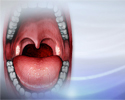Perianal streptococcal cellulitis
Perianal streptococcal cellulitis is an infection of the area around the anus and rectum. The infection is caused by streptococcus bacteria.
Causes
Perianal streptococcal cellulitis usually occurs in children. It often appears during or after strep throat, nasopharyngitis, or streptococcal skin infection (impetigo).
Strep throat
Strep throat is a disease that causes a sore throat (pharyngitis). It is an infection with a bacteria called group A streptococcus.

Impetigo
Impetigo is a common infection of the outermost layer of the skin.

The skin around the anus may get infected while a child wipes the area after using the toilet. The infection can also result from scratching the area with fingers that have bacteria from the mouth or nose.
Symptoms
Symptoms may include:
- Fever
- Itching, pain, or bleeding with bowel movements
- Redness around the anus
Exams and Tests
Your health care provider will examine the child and ask about the symptoms.
Tests that may be done include:
- Rectal swab culture
Rectal swab culture
Rectal culture is a lab test to identify bacteria and other germs in the rectum that can cause gastrointestinal symptoms and disease.
 ImageRead Article Now Book Mark Article
ImageRead Article Now Book Mark Article - Skin culture from rectal area
- Throat culture
Throat culture
A throat swab culture is a laboratory test that is done to identify germs that may cause infection in the throat. It is most often used to diagnose ...
 ImageRead Article Now Book Mark Article
ImageRead Article Now Book Mark Article
Treatment
The infection is treated with antibiotics for about 10 days, depending on how well and quickly they are working. Penicillin is the most often used antibiotic in children.
Topical medicine can be applied to the skin and is commonly used with other antibiotics, but it should not be the only treatment. Mupirocin is a common topical medicine used for this condition.
Outlook (Prognosis)
Children usually recover quickly with antibiotic treatment. It is important to contact your provider if your child does not get better soon on antibiotics.
Possible Complications
Complications are rare, but may include:
- Anal scarring, fistula, or abscess
Fistula
A fistula is an abnormal connection between two body parts, such as an organ or blood vessel and another structure. Fistulas are usually the result ...
 ImageRead Article Now Book Mark Article
ImageRead Article Now Book Mark ArticleAbscess
An anorectal abscess is a collection of pus in the area of the anus and rectum.
 ImageRead Article Now Book Mark Article
ImageRead Article Now Book Mark Article - Bleeding, discharge
- Bloodstream or other streptococcal infections (including heart, joint, and bone)
- Kidney disease (acute glomerulonephritis)
Glomerulonephritis
Glomerulonephritis is a type of kidney disease in which the part of your kidneys that helps filter waste and fluids from the blood is damaged....
 ImageRead Article Now Book Mark Article
ImageRead Article Now Book Mark Article - Severe skin and soft tissue infection (necrotizing fasciitis)
Necrotizing fasciitis
Necrotizing soft tissue infection is a rare but very severe type of bacterial infection. It can destroy the muscles, skin, and underlying tissue. T...
Read Article Now Book Mark Article
When to Contact a Medical Professional
Contact your child's provider if your child complains of pain in the rectal area, painful bowel movements, or other symptoms of perianal streptococcal cellulitis.
If your child is taking antibiotics for this condition and the area of redness gets worse, or the discomfort or fever is increasing, contact your provider immediately.
Prevention
Careful handwashing may help prevent this and other infections caused by bacteria carried in the nose and throat.
To prevent the condition from coming back (relapse), be sure your child finishes all the medicine the provider prescribes.
Reviewed By
Jatin M. Vyas, MD, PhD, Associate Professor in Medicine, Harvard Medical School; Associate in Medicine, Division of Infectious Disease, Department of Medicine, Massachusetts General Hospital, Boston, MA. Also reviewed by David C. Dugdale, MD, Medical Director, Brenda Conaway, Editorial Director, and the A.D.A.M. Editorial team.
Paller AS, Mancini AJ. Bacterial, mycobacterial, and protozoal infections of the skin. In: Paller AS, Mancini AJ, eds. Paller and Mancini - Hurwitz Clinical Pediatric Dermatology. 6th ed. Philadelphia, PA: Elsevier; 2022:chap 14.
Shulman ST, Patel AB. Group A streptococcus. In: Kliegman RM, St. Geme JW, Blum NJ, et al, eds. Nelson Textbook of Pediatrics. 22nd ed. Philadelphia, PA: Elsevier; 2025:chap 229.

 All rights reserved.
All rights reserved.